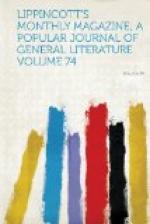One other point may be mentioned with reference to these balls, as a small contribution to the history of a system of social manners and usages which has now passed away. The utmost latitudinarianism, as has been mentioned, was allowed in the matter of costume, but this rule was subject to one exception. On the night of New Year’s Day, on which there was always a ball at the Pitti, all those who attended it were expected to appear in proper court-dress. Those who were entitled to any official costume, military or other, donned that. I have seen a clergyman of the Church of England make his academical robes do duty as a court-dress, as indeed they properly do at St. James. But in the rooms at the Pitti His Reverence became the observed of all observers to a remarkable degree. Those who could lay claim to no official costume of any sort had to fall back on the old court-dress of the period of George I., still worn, oddly enough, at the English court. It is a sufficiently handsome dress in itself, and had at all events the advantage of looking extremely unlike the ordinary costume of nineteenth-century mortals, It was often a question with American civilians what dress they should wear on these occasions, and I used to endeavor to persuade my American friends to insist upon their republican right to ignore in Europe court-tailor mummeries of which they knew nothing at home; being perfectly sure that they would have carried the point victoriously, and not unmindful of Talleyrand’s remark when Castlereagh at Vienna appeared in a plain black coat, without any decoration, among the crowd of continental diplomatists bedizened with ribbons of every color and stars and crosses of every form and kind: “Ma foi! c’est fort distingue!” But I never could prevail, having, as I take it, the female influence against me on the subject; and Americans used to adopt generally a blue cloth coat and trousers well trimmed with gold lace, and a white waistcoat.
In later days, when popular discontent and the agitation arising from it were gradually boiling up to a dangerous height in every part of Italy, and the hatred felt toward the different sovereigns was reflected in many an audacious squib and satire, the grand duke of Tuscany never shared to any great degree the odium which pursued his fellow-monarchs. It was with a scathing vigor of satire that Giuseppe Giusti characterized each of the Italian crowned heads of that period in burning verses, which were circulated with cautious secresy in manuscript from hand to hand, long before a surreptitious edition, which it was dangerous (anywhere in Italy save in Tuscany) to possess, appeared, to be followed in after years by many an avowed one. These have given the name of Giusti a high and peculiar place on the roll of Italian poets. But the satirist’s serpent scourge is changed for a somewhat contemptuously used foolscap when the Tuscan ruler is introduced in the following lines:
Il Toscano Morfeo vien’ lemme, lemme,
Di pavavero cinto e di lattuga.




